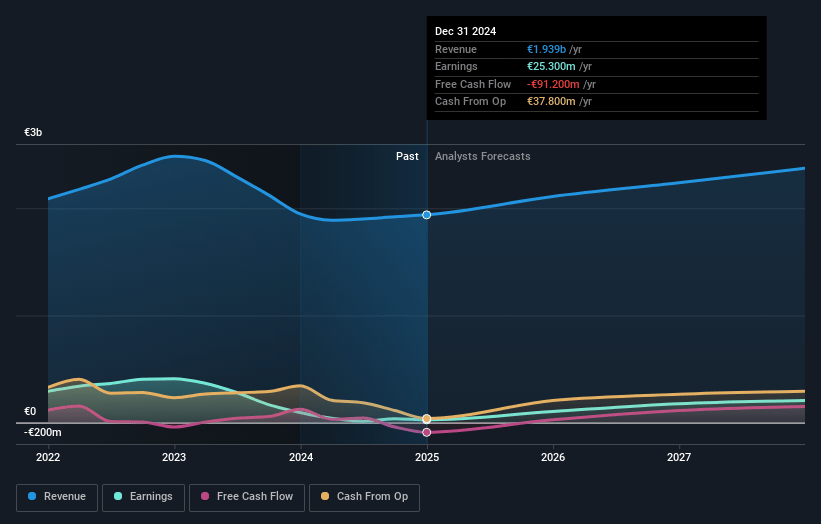Key Takeaways
- Operational improvements and strategic investments are expected to enhance earnings, profitability, and boost revenues from completed projects and mill efficiencies.
- Focus on strengthening cash flow and maintaining strong U.S. market relationships will support financial stability and potential revenue growth despite external challenges.
- Geopolitical challenges, weak consumer demand, and cost pressures are impacting Metsä Board's revenue, profitability, and operational cash flow.
Catalysts
About Metsä Board Oyj- Engages in the folding boxboard, fresh fibre linerboard, and market pulp businesses in Finland and internationally.
- The closure of the Tako mill and enhancement of operational efficiency at the Kyro mill are expected to improve the company's annual EBITDA by approximately €30 million, beginning mainly in the fourth quarter of 2025. This is likely to positively impact earnings and profitability.
- Major investments are now completed, with returns expected in the coming years. The ongoing paperboard machine renewal in Simpele is anticipated to finish in the second half of the year, potentially boosting revenues and earnings.
- Metsä Board is focusing on strengthening cash flow by reducing operating working capital, with expectations for a stronger operating cash flow in the second half of the year compared to the first. This should improve net cash flow and operational liquidity.
- Despite geopolitical challenges such as U.S. tariffs, Metsä Board has maintained a solid financial position and strong customer relationships in the U.S. market, providing a stable base for future revenue growth as market conditions improve.
- The company is committed to enhancing mill and product competitiveness and is planning actions to improve profitability, suggesting potential improvements in net margins through operational efficiencies and strategic product positioning.
Metsä Board Oyj Future Earnings and Revenue Growth
Assumptions
How have these above catalysts been quantified?- Analysts are assuming Metsä Board Oyj's revenue will grow by 4.9% annually over the next 3 years.
- Analysts assume that profit margins will increase from 0.3% today to 6.7% in 3 years time.
- Analysts expect earnings to reach €151.2 million (and earnings per share of €0.42) by about July 2028, up from €5.2 million today. However, there is a considerable amount of disagreement amongst the analysts with the most bullish expecting €211.2 million in earnings, and the most bearish expecting €121.7 million.
- In order for the above numbers to justify the analysts price target, the company would need to trade at a PE ratio of 13.3x on those 2028 earnings, down from 224.9x today. This future PE is lower than the current PE for the GB Packaging industry at 114.3x.
- Analysts expect the number of shares outstanding to grow by 7.0% per year for the next 3 years.
- To value all of this in today's terms, we will use a discount rate of 6.12%, as per the Simply Wall St company report.
Metsä Board Oyj Future Earnings Per Share Growth
Risks
What could happen that would invalidate this narrative?- Metsä Board is facing geopolitical challenges, specifically U.S. tariffs, which create significant uncertainty in the company's future paperboard sales and earnings development, potentially impacting its revenue and profitability.
- The company's operating cash flow has been unsatisfactory and negative, primarily due to prolonged weak profitability and increased working capital requirements, affecting cash reserves and net margins.
- There is weak consumer demand for paperboards, with demand not reaching pre-pandemic levels, potentially limiting revenue growth.
- Increased production activities have led to higher inventory levels, tying up working capital and further affecting operational cash flow.
- The company is experiencing heightened costs in areas such as wood, logistics, and employee expenses, accompanied by higher depreciation, which are reducing net earnings and profitability.
Valuation
How have all the factors above been brought together to estimate a fair value?- The analysts have a consensus price target of €3.875 for Metsä Board Oyj based on their expectations of its future earnings growth, profit margins and other risk factors. However, there is a degree of disagreement amongst analysts, with the most bullish reporting a price target of €5.0, and the most bearish reporting a price target of just €3.25.
- In order for you to agree with the analyst's consensus, you'd need to believe that by 2028, revenues will be €2.2 billion, earnings will come to €151.2 million, and it would be trading on a PE ratio of 13.3x, assuming you use a discount rate of 6.1%.
- Given the current share price of €3.29, the analyst price target of €3.88 is 15.0% higher.
- We always encourage you to reach your own conclusions though. So sense check these analyst numbers against your own assumptions and expectations based on your understanding of the business and what you believe is probable.
How well do narratives help inform your perspective?
Disclaimer
AnalystConsensusTarget is a tool utilizing a Large Language Model (LLM) that ingests data on consensus price targets, forecasted revenue and earnings figures, as well as the transcripts of earnings calls to produce qualitative analysis. The narratives produced by AnalystConsensusTarget are general in nature and are based solely on analyst data and publicly-available material published by the respective companies. These scenarios are not indicative of the company's future performance and are exploratory in nature. Simply Wall St has no position in the company(s) mentioned. Simply Wall St may provide the securities issuer or related entities with website advertising services for a fee, on an arm's length basis. These relationships have no impact on the way we conduct our business, the content we host, or how our content is served to users. The price targets and estimates used are consensus data, and do not constitute a recommendation to buy or sell any stock, and they do not take account of your objectives, or your financial situation. Note that AnalystConsensusTarget's analysis may not factor in the latest price-sensitive company announcements or qualitative material.









